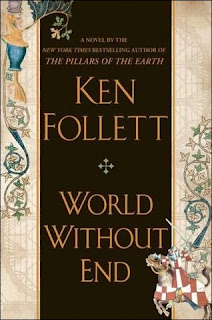World Without End
Summary (from the publisher): In 1989 Ken Follett astonished the literary world with The Pillars of the Earth, a sweeping epic novel set in twelfth-century England centered on the building of a cathedral and many of the hundreds of lives it affected. Critics were overwhelmed and readers everywhere hoped for a sequel.
World Without End takes place in the same town of Kingsbridge, two centuries after the townspeople finished building the exquisite Gothic cathedral that was at the heart of The Pillars of the Earth. The cathedral and the priory are again at the center of a web of love and hate, greed and pride, ambition and revenge, but this sequel stands on its own. This time the men and women of an extraordinary cast of characters find themselves at a crossroad of new ideas— about medicine, commerce, architecture, and justice. In a world where proponents of the old ways fiercely battle those with progressive minds, the intrigue and tension quickly reach a boiling point against the devastating backdrop of the greatest natural disaster ever to strike the human race: —the Black Death.
Three years in the writing, and nearly eighteen years since its predecessor, World Without End breathes new life into the epic historical novel and once again shows that Ken Follett is a masterful author writing at the top of his craft.
Review: I loved this novel even more than its predecessor, The Pillars of the Earth. I loved the idea of having the common factor between the novels be a location and a place rather than characters. This novel is set two hundred years after the first novel, and is still grounded in Kingsbridge and the great cathedral that was built in the first novel. While several of the characters are descendants from main characters of the first novel and have similar traits/occupations, they can be read in any order, which is fortunate, because the plots are intricate and the characters are many.
I felt deeply attached to the characters in this novel, especially Gwenda, and also the star crossed lover story of Caris and Merthin. There was a definitely a reprisal of Jack and Aliena in Caris and Merthin, but it's a great story, and I was happy to indulge in it again. I also never lost respect for Merthin (surprisingly), despite his numerous entanglements with other women. He never faltered in his love for Caris, but circumstances simply got in the way of their love repeatedly.
I realize that this is sort of twisted, but I also really enjoyed the plague or the Black Death in this novel. I loved how it made Caris rise to the occasion, and become a respected healer. I also liked the psychological portrait of a society where death seems imminent - nothing else seems important in the face of death. It altered the course of the characters paths in interesting ways.
Constructive criticism: Follett has a bad habit of making his villains too villainous. They're too easy to hate. A better villain would be one that had both good and bad, to create a more nuanced dynamic in the novel. Additionally, the characters are introduced too quickly. A dozen characters are introduced in the opening scenes, and it's difficult for readers to keep characters straight and discern between them.
This novel is long. It's an investment of extensive time to make it through the over 1,000 pages. But its tells numerous stories of several characters. And by the end of the novel, I felt like I knew the characters and didn't want the story to end. I would love to read more novels about Kingsbridge.
Stars: 4.5



Comments
Post a Comment